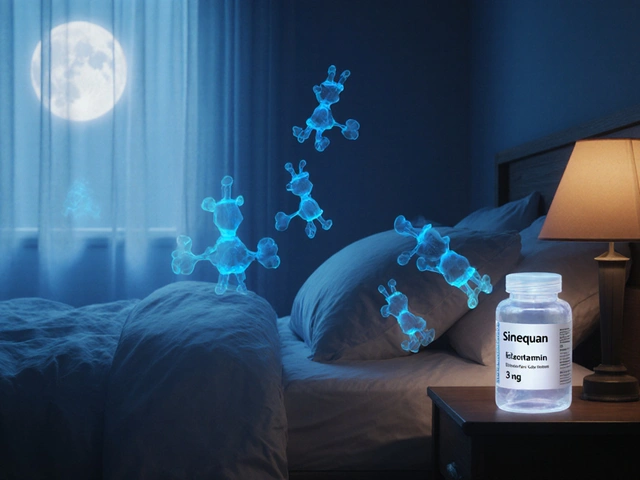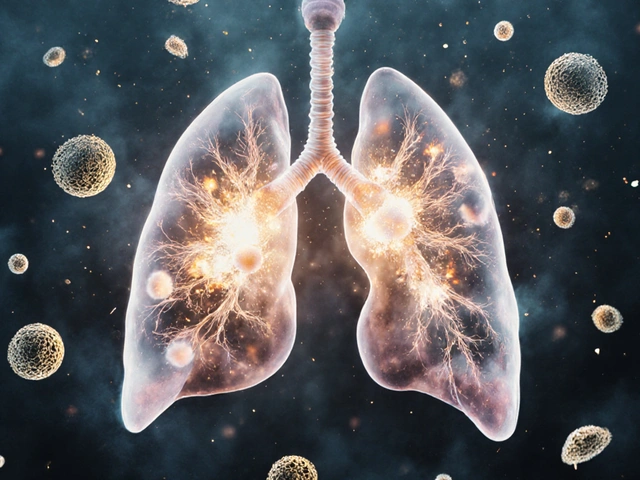
STI Fluoroquinolone Resistance Checker
Check Ofloxacin Appropriateness
This tool helps determine if Ofloxacin is appropriate for Chlamydia or Gonorrhea treatment based on CDC guidelines and local resistance data.
Every year the CDC reports more than 2.4 million cases of chlamydia and 600,000 cases of gonorrhea in the United States alone. While azithromycin and doxycycline dominate first‑line therapy, clinicians sometimes need a backup plan when patients can’t tolerate those drugs or when resistance pops up. That’s where Ofloxacin enters the picture.
What is Ofloxacin?
Ofloxacin is a broad‑spectrum fluoroquinolone antibiotic that inhibits bacterial DNA gyrase and topoisomerase IV, crippling DNA replication. Approved in the early 1990s, it’s marketed under names like Floxin and Tarivid. Oral tablets come in 200 mg and 400 mg strengths, while an IV formulation exists for severe infections.
How Ofloxacin Tackles Chlamydia and Gonorrhea
Both Chlamydia trachomatis a Gram‑negative intracellular bacterium that causes the most reported sexually transmitted infection worldwide and Neisseria gonorrhoeae the pathogen responsible for gonorrhea, a Gram‑negative diplococcus are susceptible to fluoroquinolones in vitro. Ofloxacin’s ability to penetrate urogenital tissues, reach intracellular compartments, and maintain bactericidal concentrations makes it a viable alternative when first‑line agents fail.
CDC Guidelines: Where Does Ofloxacin Fit?
The Centers for Disease Control and Prevention U.S. federal agency that issues evidence‑based treatment recommendations for STIs still lists azithromycin (1 g single dose) or doxycycline (100 mg BID for 7 days) as preferred regimens. Ofloxacin appears only as a secondary option for patients allergic to macrolides or tetracyclines, or when local resistance data show >10 % fluoroquinolone resistance in gonorrhea isolates.
When to Choose Ofloxacin
- Documented allergy to azithromycin or doxycycline.
- Pregnancy is not a factor (ofloxacin is Category C; avoid unless benefits outweigh risks).
- Local antimicrobial‑surveillance reports low fluoroquinolone resistance (<5 %).
- Patient prefers a single‑day oral regimen rather than a week‑long course.
Dosage Regimens
For uncomplicated urogenital infections, the most common dosing is:
- Chlamydia: 400 mg orally once, then 200 mg 12 hours later (total 600 mg).
- Gonorrhea: 400 mg orally as a single dose; if there’s a concern for co‑infection with chlamydia, add a second 200 mg dose 12 hours later.
Both regimens should be taken with a full glass of water, and patients must avoid antacids within two hours of the dose to prevent reduced absorption.

Clinical Evidence and Cure Rates
Randomized trials from the early 2000s showed cure rates of 94 % for chlamydia and 88 % for gonorrhea when patients received the dosing schedule above. More recent observational data from clinics in the Pacific Northwest (2022‑2024) suggest that, in settings with documented low fluoroquinolone resistance, cure rates remain above 90 % for both pathogens.
Safety Profile and Side Effects
Ofloxacin is generally well tolerated, but clinicians should watch for:
- Gastrointestinal upset (nausea, diarrhea).
- Central nervous system effects (headache, dizziness, rare seizures).
- Tendinopathy, especially in patients over 60 or those on corticosteroids.
- QT‑interval prolongation - avoid in patients with known cardiac arrhythmias.
Contraindications include a history of hypersensitivity to fluoroquinolones and patients with known retinal disorders.
Drug Interactions
Key interactions to flag:
- Antacids containing magnesium or aluminum - can chelate ofloxacin and cut absorption.
- Warfarin - may increase INR; monitor coagulation if co‑prescribed.
- Cytochrome‑P450 inducers (e.g., rifampin) - may lower plasma levels.
Comparison with Other STD Antibiotics
| Attribute | Ofloxacin | Azithromycin | Doxycycline |
|---|---|---|---|
| Drug class | Fluoroquinolone | Macrolide | Tetracycline |
| Mechanism | DNA gyrase & topoisomerase IV inhibition | Protein synthesis inhibition (50S ribosomal subunit) | Protein synthesis inhibition (30S ribosomal subunit) |
| Typical dose (chlamydia) | 400 mg once + 200 mg 12 h later | 1 g single dose | 100 mg BID for 7 days |
| Typical dose (gonorrhea) | 400 mg single dose | 1 g single dose | Not first‑line; 100 mg BID for 7 days if used |
| Cure rate (chlamydia) | ≈94 % | ≈97 % | ≈95 % |
| Cure rate (gonorrhea) | ≈88 % (low resistance sites) | ≈95 % (if susceptible) | ≈90 % (when used) |
| Common side effects | Nausea, headache, tendinopathy | GI upset, possible rash | Photosensitivity, esophagitis |
Practical Prescribing Tips
- Confirm patient’s allergy history - avoid ofloxacin if macrolide or tetracycline allergic.
- Check local antibiograms - many urban clinics now report >10 % fluoroquinolone resistance in gonorrhea.
- Discuss adherence - a two‑dose schedule is easier than a 7‑day doxycycline course.
- Advise on avoiding antacids for two hours before/after the dose.
- Schedule a test‑of‑cure (NAAT) 1‑2 weeks after therapy, especially for gonorrhea.
Resistance Trends and Future Outlook
Fluoroquinolone resistance in Neisseria gonorrhoeae has risen sharply worldwide, now exceeding 20 % in many regions. The CDC warns clinicians to reserve ofloxacin for cases where susceptibility is documented. Ongoing surveillance programs (e.g., GISP in the U.S.) are critical for keeping the backup armamentarium viable.
Quick Checklist for Clinicians
- Is the patient allergic to azithromycin or doxycycline?
- Do local labs show <5 % fluoroquinolone resistance?
- Is the patient ≥ 18 years and not pregnant?
- Provide clear dosing instructions: 400 mg once, 200 mg 12 h later for chlamydia; 400 mg once for gonorrhea.
- Arrange follow‑up testing to confirm eradication.
Frequently Asked Questions
Can I take Ofloxacin if I’m pregnant?
Ofloxacin is classified as Pregnancy Category C. It should be avoided unless the potential benefit to the mother outweighs the risk to the fetus. Safer alternatives like azithromycin are preferred during pregnancy.
How fast does Ofloxacin work for chlamydia?
Symptoms often improve within 2‑3 days, but a full eradication takes the entire dosing course. A test‑of‑cure is recommended 1 week after therapy.
What should I avoid while taking Ofloxacin?
Skip antacids containing magnesium or aluminum for at least two hours before and after each dose. Also, avoid strenuous exercise for the first few days to reduce tendinopathy risk.
Is Ofloxacin effective against antibiotic‑resistant gonorrhea?
Only in areas where local resistance testing shows susceptibility. In most U.S. regions, fluoroquinolone resistance exceeds the CDC threshold, making it a less reliable choice.
Can Ofloxacin be used for both infections in the same patient?
Yes. A single 400 mg dose covers gonorrhea, and adding a 200 mg dose 12 hours later treats concurrent chlamydia.





Diane Thurman
October 22, 2025 AT 20:47Ofloxacin sounds like a last‑ditch gimmick.
Sarah Riley
October 28, 2025 AT 15:40The pharmacokinetic paradigm of fluoroquinolones, particularly Ofloxacin, aligns with a niche therapeutic niche; nevertheless, the resistance vectors remain formidable. Clinical stewardship mandates reserving such agents for documented contraindications. The therapeutic index, albeit sufficient, is not without caveats.
Sajeev Menon
November 3, 2025 AT 05:00Hey folks, just wanted to add a friendly note. Ofloxacin can be a decent backup when azithromycin or doxy cause side‑effects, but you should always check local susceptibility patterns. Also, remember to advise patients about the antacid interaction – take it two hours apart. If the patient is pregnant, weigh the risks carefully; it’s a Category C drug. Stay safe and keep your prescribing practices evidence‑based.
Emma Parker
November 8, 2025 AT 12:47Yo, I totally get the struggle with doxy’s 7‑day grind. Ofloxacin’s two‑dose schedule is a breeze for compliance, especially for busy folks. Just make sure they aren’t on antacids, that can mess with absorption. And yeah, a test‑of‑cure is a must, especially for gonorrhea.
Joe Waldron
November 13, 2025 AT 15:00When considering Ofloxacin, one must evaluate the antimicrobial spectrum, the pharmacodynamics, and the patient’s comorbidities, all of which are critical, especially in the context of rising fluoroquinolone resistance, which the CDC highlights as a growing concern, thus reserving Ofloxacin for documented allergies or proven susceptibility, ensures stewardship, and mitigates the propagation of resistant strains, ultimately preserving its utility as a viable second‑line agent.
Wade Grindle
November 18, 2025 AT 11:40Just a heads‑up, the local labs in many states now report >10% fluoroquinolone resistance in gonorrhea isolates. If you’re in that zone, think twice before picking Ofloxacin as a backup.
Sameer Khan
November 23, 2025 AT 02:47From a pharmacological standpoint, Ofloxacin’s mechanism-targeting DNA gyrase and topoisomerase IV-confers bactericidal activity that is both concentration‑dependent and time‑dependent.
However, the clinical efficacy is intrinsically linked to the pathogen’s susceptibility profile, which varies geographically.
Empirical use without susceptibility data risks therapeutic failure and may accelerate resistance selection.
In the context of Chlamydia trachomatis, intracellular penetration is paramount; Ofloxacin’s lipophilicity facilitates entry into host cells, yet doxycycline remains superior due to its intracellular accumulation.
For Neisseria gonorrhoeae, fluoroquinolone resistance has escalated globally, with molecular mechanisms such as mutations in gyrA and parC genes rendering Ofloxacin ineffective in a substantial subset of isolates.
Hence, the CDC’s recommendation to reserve Ofloxacin for documented allergies or proven susceptibility aligns with antimicrobial stewardship principles.
Furthermore, the risk–benefit calculus must consider patient‑specific factors: pregnancy (Category C), renal function, and potential drug‑drug interactions, notably with antacids containing polyvalent cations.
Therapeutic drug monitoring is not routinely performed for Ofloxacin, but adherence to the dosing schedule-typically a single 400 mg dose or split 200 mg doses-enhances plasma concentrations above the MIC for susceptible strains.
Importantly, the test‑of‑cure using nucleic acid amplification tests (NAAT) 1–2 weeks post‑therapy remains essential to confirm microbiological eradication, especially given the potential for asymptomatic persistence.
Clinicians should also be vigilant for adverse effects, such as tendinopathy and QT prolongation, which, although rare, warrant patient counseling.
In settings where local surveillance indicates <10% fluoroquinolone resistance, Ofloxacin may be a pragmatic alternative, provided that susceptibility testing is performed prior to initiation.
Ultimately, the decision to employ Ofloxacin must integrate epidemiological data, individual patient contraindications, and the overarching goal of preserving future therapeutic options.
Continuous surveillance through programs like GISP is indispensable for informing guideline updates and ensuring that Ofloxacin remains a viable component of the STI treatment armamentarium.
In summary, while Ofloxacin offers a mechanistically sound option, its use should be judicious, evidence‑based, and tailored to the nuanced clinical scenario at hand.
Kiara Gerardino
November 27, 2025 AT 12:20Honestly, prescribing Ofloxacin as a “backup” feels like a moral compromise-an admission that our first‑line agents are failing the public health mandate.
We should be ashamed to rely on an antibiotic whose resistance is skyrocketing.
Choosing convenience over efficacy undermines the fight against STIs.
It’s time to hold ourselves to higher standards.
Tim Blümel
December 1, 2025 AT 16:20Totally get the passion here 😊. At the end of the day, patient safety and real‑world data should drive our choices.
Let’s keep the conversation evidence‑focused.
Michael Vandiver
December 5, 2025 AT 14:47great points, i think we should also consider cost and access why not share resources and keep monitoring locals trends
Suryadevan Vasu
December 9, 2025 AT 07:40Agreed. Surveillance data is key, keep it concise and actionable.